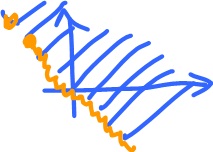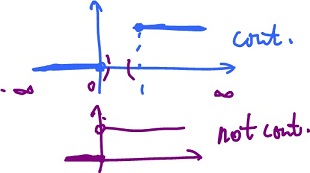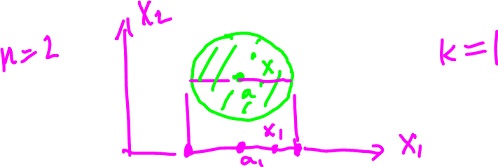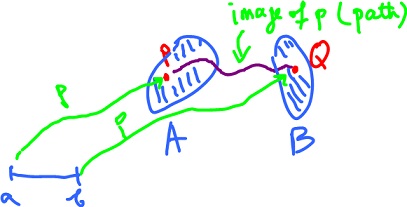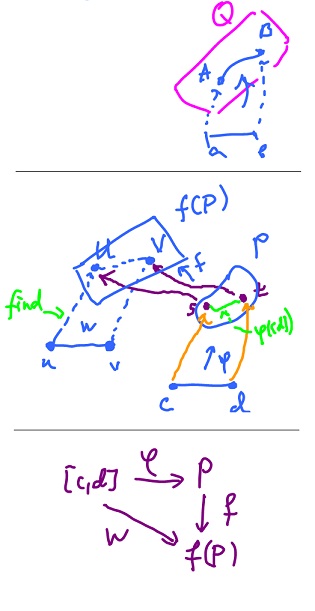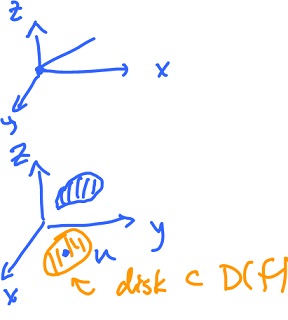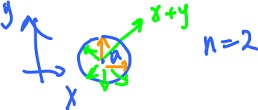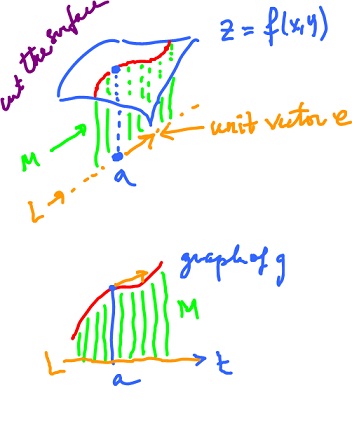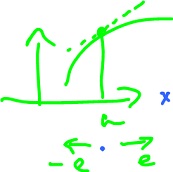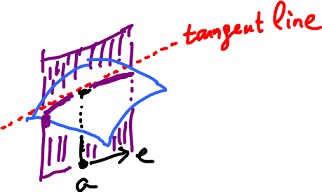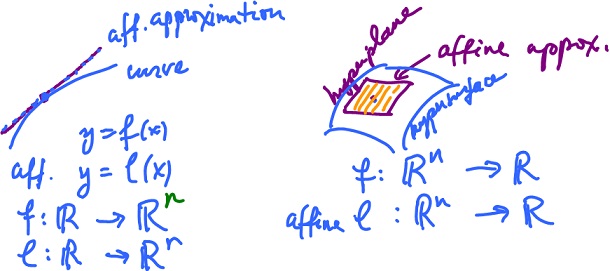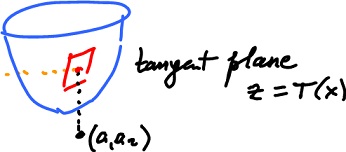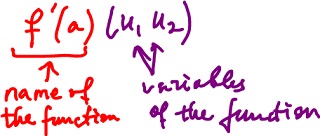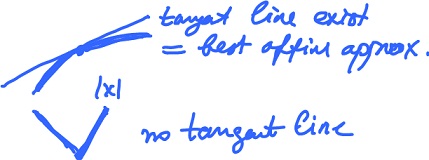This site is being phased out.
Functions of several variables OLD
Contents
Continuity
Before we consider continuity of functions of several variables, let's recall how the issue is handled in Calc1 as there is a subtle difference.
Problem. For the function $f(x) = \sqrt{x}$ discuss continuity.
- at $x = 0$, $f$ is not continuous. However it is right-continuous at $\{0 \}$ as $x = 0$ is the end point of $D(f)$.
- at $x > 0$, $f$ is continuous.
- for $x < 0$, $f$ is undefined.
Thus $f$ is continuous on on $( 0, {\infty} )$ or continuous in the extended sense on $[ 0, {\infty} )$.
Recall the definition. A function $f: {\bf R} {\rightarrow} {\bf R}, f(x) = y,$ is continuous at point $a {\in} {\bf R}$ if for any ${\epsilon} > 0$ there is a ${\delta} > 0$ such that
$$| x - a | < {\delta} \rightarrow | f(x) - f(a) | < {\epsilon}.$$
Note that the definition implicitly assumes that $x, a {\in}$ $D(f)$.
How does the definition change in the $n$-dimensional case?
Definition. A function $f: {\bf R}^n {\rightarrow} {\bf R}, f(x) = y,$ is continuous at point $a {\in} D(f)$ if for any ${\epsilon} > 0$ there is a ${\delta} > 0$ such that
$$|| x - a || < {\delta} {\rm \hspace{3pt} and \hspace{3pt}} x {\in} D(f) \rightarrow || f(x) - f(a) || < {\epsilon}.$$
First, we have replaces the absolute value with the norm. This simply reflect the way we measure "closeness" in ${\bf R}$ versus in ${\bf R}^n$ (see Continuous functions).
Second, $x$ is required to be in the domain of $f$. This makes a difference. With the new definition, $\sqrt{x}$ is continuous on $[ 0, {\infty} )$ (verify). Thus one-side continuity is no longer an issue.
Now for ${\rm dim \hspace{3pt}} > 1$.
Example. Consider $f( x, y ) = ( x + y )^{\frac{1}{2}}, D(f) = \{ ( x, y ): x + y \geq 0 \}.$ Without actually verifying the definition, we see that the function is continuous on the whole domain - the half-plane including the border.
Example. Let $f(x) = 0$ if $x \leq 0, f(x) = 1$ if $x \geq 1.$
Is $f$ continuous? Yes! It is surprising, but since the domain is "disconnected", the function can't be (unlike the second example on the right).
Example. Let $f(x) = c$ a constant function. Then $|| f(x) - f(a) || = || c - c || = 0 < {\epsilon}$, so $f$ is continuous.
Theorem. Let $f: {\bf R}^n {\rightarrow} {\bf R}, f_k(x) = x_k,$ be the projection, where $x = ( x_1, ..., _n ).$ Then f is continuous.
(For example, if $n = 3, f_2 ( 1, 5, 7 ) = 5$.)
Proof. Consider $f_k(x) = a_k,$ where $a = ( a_1, ..., a_n ).)$
In order to show this, we have to find ${\delta}$ for a given ${\epsilon} > 0$. We hence want to show that for
$$|| x - a || < {\delta} $$
it follows that
$$| f_k(x) - f_k(a) | = | x_k - a_k | < {\epsilon}.$$
We rewrite $( ( x_1 - a_1 )^2 + ( x_2 - a_2 )^2 + ... )^{\frac{1}{2}} < {\delta},$ and $( ( x_1 - a_1 )^2 + ( x_2 - a_2 )^2 + ... )^{\frac{1}{2}} \geq ( ( x_k - a_k )^2 )^{\frac{1}{2}} = | x_k - a_k | < {\epsilon}.$
Choose ${\delta} = {\epsilon}$. Then if $$( ( x_1 - a_1 )^2 + ( x_2 - a_2 )^2 + ... )^{\frac{1}{2}} < {\delta} = {\epsilon},$$
then $$| x_k - a_k | < {\epsilon}.$$
For more see Continuity of functions of several variables.
Continuity under algebraic operations
Let's create new functions from old, using $+, -, \cdot, /, \circ$, and see how this affect continuity.
Theorem (Sum). If $f, g: {\bf R}^n {\rightarrow} {\bf R}$ are continuous at $x = a$, then so is $f + g$.
Proof. Let $h = f + g.$ We want to show that for every ${\epsilon} > 0$, there is a ${\delta} >0$ such that
$$| x - a | < {\delta}, x {\in} D(h) \rightarrow | h(x) - h(a) | < {\epsilon}.$$
Let's write the definition of continuity twice - for $f$ and $g$. As it turns out, choosing $\frac{\epsilon}{2}$ is preferable in order to get from these to the one above.
- there is a ${\delta}_1 > 0$ such that $| x - a | < {\delta}_1, x {\in} D(f) \rightarrow | f(x) - f(a) | < \frac{\epsilon}{2},$
- there is a ${\delta}_2 > 0$ such that $| x - a | < {\delta}_2, x {\in} D(g) \rightarrow | g(x) - g(a) | < \frac{\epsilon}{2}.$
Let ${\delta} = {\rm min}( {\delta}_1, {\delta}_2 ). $ Then ${\delta}_1, {\delta}_2 \leq {\delta}.$
Hence we can re-write the above two definitions as follows:
To get to $h$, use the two inequalities: $$\begin{array}{} | h(x) - h(a) | &= | ( f(x) + g(x) ) - ( f(a) + g(a) ) | \\ &= | ( f(x) - f(a) ) + ( g(x) - g(a) ) | \\ &\leq | f(x) - f(a) | + | g(x) - g(a) | ({\rm Triangle \hspace{3pt} Inequality}) \\ &< \frac{\epsilon}{2} + \frac{\epsilon}{2} = {\epsilon}. QED \end{array}$$
Theorem (Constant Multiple). If $f: {\bf R}^n {\rightarrow} {\bf R}$ is continuous at $a$ and $c$ is a constant, then $c \cdot f$ is continuous at $a$.
Hint: $$| cf(x) - cf(a) | = | c | | f(x) - f(a) |$$
with $f$ continuous, and we have to show that
$$| c | | f(x) - f(a) | < {\epsilon}.$$
Choose ${\delta} = \frac{\epsilon}{| c |}$.
Theorem (Product). Let $f, g: {\bf R}^n {\rightarrow} {\bf R}$ be continuous at $a$. Then $f \cdot g$ is continuous at $a$.
Theorem (Ratio). Let $f, g: {\bf R}^n {\rightarrow} {\bf R}$ be continuous at $a$. Then $\frac{f}{g}$ is continuous at $a$, provided $g(a) \neq 0$.
Theorem (Composition). Let $f: {\bf R}^n {\rightarrow} {\bf R}, g: {\bf R} {\rightarrow} {\bf R}$, where $f$ is continuous at $a$ and $g$ is continuous at $f(a)$. Then $h = g \circ f$ is continuous at $a$.
Read the proof.
Exercise. Prove $f( x, y ) = x + y$ is continuous, from the definition.
Exercise. Prove $f(u) = || u ||$ is continuous, two ways.
- from the definition: use $|| u - a || < {\delta} \rightarrow | ||u|| - ||a|| | < {\epsilon}$;
- from the theorems: use $f(u) = ( x_1^2 + ... + x_n^2 )^{\frac{1}{2}}$.
Theorem. Affine functions are continuous.
Proof. Recall $f(x) = Ax + b, Ax = < v, x > = v_1 x_1 + ... + v_n x_n$
Now, the definition:
$$|| x - a || < {\delta} ⇒ | ( Ax + b ) - ( Aa + b ) | < {\epsilon},$$
where
$$\begin{array}{} | ( Ax + b ) - ( Aa + b ) | &= | Ax - Aa | \\ &= | A ( x - a ) | \\ &= | < v, x - a > | \\ &= || v || \cdot || x - a || \\ &< {\epsilon}. \end{array}$$
Then choose ${\delta} = \frac{\epsilon}{|| v ||}$ if $v \neq 0$. If $v = 0$, then $f$ is constant. QED
See also Continuity under algebraic operations.
Topology
To define derivatives we need limits and for limits we need to understand better the topology of the underlying (domain) space, ${\bf R}^n$. Its topology is much more complex than that of ${\bf R}$.
Recall, how the fact that the domain of the function is made of two pieces affects its continuity:
- $D(f) = ( -{\infty}, 0 ] {\cup} [ 1, {\infty} )$, i.e. "two pieces" and $f$ is continuous!
- Even if undefined at the end points, it's still continuous.
- Even if these end points are the same point, still two pieces and still continuous. Here $1 \not\in D(f) = ( -{\infty}, 1 ) {\cup} ( 1, {\infty} )$
- This one is not continuous! $D(f) = ( -{\infty}, 1 ] {\cup} ( 1, {\infty} ) = {\bf R}$, one piece!
(Proof of 4: Let $a = 1, x = 1 + {\epsilon}, {\epsilon} > 0. | f(x) - f(a) | = | 1 - 0 | = 1.$ Finish...)
What is the point? Continuity of a function depends on the topology of its domain, specifically, its connectedness.
Suppose $X = A {\cup} B {\subset} {\bf R}^n$ and $A$ and $B$ are disjoint.
Is there a continuous path from $P$ to $Q$?
Definition. A subset $X$ of ${\bf R}^n$ is called path-connected if for any $P, Q {\in} X$ there is a continuous function $p: [ a, b ] {\rightarrow} {\bf R}^n$ such that
$$p(a) = P, p(b) = Q.$$
Examples:
Theorem. $X = {\bf R}^n$ is path-connected.
Proof. In order to prove the claim, we have to find the path from $P$ to $Q$ for any given $P, Q {\in} {\bf R}^n$. The idea is to use a straight line.
Define $p: [ a, b ] {\rightarrow} {\bf R}^n$ by
$$p(t) = ( Q - P ) t + P.$$
(This is a convex combination of $P$ and $Q$.) Prove now that $p$ is continuous with $p(0) = P, p(1) = Q$. QED
Exercise. Let $X = B^n$ denote a closed ball. Is it path-connected? Yes. Proof is same as above.
Exercise. Apply the same proof to show that any convex set is path-connected (think of a box, a square, a 3d cylinder, etc).
Exercise. The same proof cannot be applied for donuts or circles, since they have holes and aren't convex.
Exercise. Let $X = [ 0, 1 ] × {0} {\cup} {0} × [ 0, 1 ],$ where
$[ 0, 1 ] \times \{0 \}$ denotes the vertical axis and is path-connected.
Let further $P = ( 1, 0 ), Q = ( 0, 1 ).$
Now let us find the path from $P$ to $Q$. Define piecewise
$p(t) = ( 0, t - 1 ), 1 \leq t \leq 2$ (continuous).
In order to prove continuity, we verify only at point $a = 1$. Finally, $p: [ 0, 2 ] {\rightarrow} {\bf R}^2$ "Image",
$p(2) = ( 0, 2 - 1 ) = ( 0, 1 ) = Q.$
Theorem. If $A, B$ are path-connected and $A \cap B \neq \emptyset$, then $A {\cup} B$ is path-connected.
Proof The idea is to combine functions for $A$ and $B$. Given $P, Q {\in} A {\cup} B$, find the path. Pick $N {\in} A \cap B$. Suppose $P {\in} A, Q {\in} B$. From connectedness of $A$ and $B$ it follows that we can
- find the path from $P$ to $N$, where $p: [ a, b ] {\rightarrow} A$, and
- find the path from $N$ to $Q$, where $q: [ c, d ] {\rightarrow} B$.
Then combine $p$ and $q$ into a path from $P$ to $Q$. Define
with $r$ continuous, $r: [ \cdot ] {\rightarrow} {\bf R}^n$. QED
Exercise. Let $X$ be a circle, which is not convex. Prove that $X$ is connected. Give an explicit formula for the path.
Theorem (Path-connectedness in ${\bf R}$). In ${\bf R}$, the path-connected sets are:
- intervals (open, closed, half-open, finite, infinite),
- single points,
- the empty set,
and these only
In order to prove the theorem, show
- These sets are connected, i.e., construct a continuous function on an interval (they are convex!).
- There are no other connected sets.
Theorem. The image of a path-connected set under a continuous function is path-connected, or: $f: {\bf R}^n {\rightarrow} {\bf R}$ continuous and $A {\subset} {\bf R}^n$ is path-connected, then
Recall from Calc1.
Intermediate Value Theorem. Let $A = f(a), B = f(b)$, and $f$ continuous.
Let further $A \leq C \leq B.$ Then there is $c {\in} [ a, b ]$ with $f(c) = C$.
Observe that if $A, B {\in} f( [ a, b ])$, then $C {\in} f( [ a, b ])$. What does it tell about the topology of $f( [ a, b ])$?
Rephrased IVT. $f( [ a, b ])$ is path-connected (an interval).
Then more general is this.
Theorem. Let $f: {\bf R}^n {\rightarrow} {\bf R}^m$ and $P {\subset} D(f) {\subset} {\bf R}^n$ be path-connected. Then $f(P)$ is path-connected.
Proof. Idea: re-state the problem of finding the necessary path in $f(P)$ as a problem of finding a certain path in $P$.
Recall the definition: A set $Q$ is path-connected if for any $A, B {\in} Q$ there is a continuous function $p: [ a, b ] {\rightarrow} Q$ such that
$$p(a) = A and p(b) = B.$$
Set $Q = f(P), A = V, B = V$, in this definition. We have to show that there is a continuous function
$$w: [ u, v ] {\rightarrow} f(P)$$
such that
$$w(u) = U {\rm \hspace{3pt} and \hspace{3pt}} w(v) = V.$$
Every point is $f(P)$ comes from $P$, then $U = f(s)$ and $V = f(t)$ for some $s, t {\in} P$ (preimages of $U,V$ under $f$).
We then use the path-connectedness of $P$. We set $Q = P, A = s, B = t$, in the above definition. Then there is a continuous function $\varphi: [ c, d ] {\rightarrow} P$ such that $\varphi(c) = s, \varphi(d) = t.$
Now let $w = f {\circ} \varphi$, and let $u = c, v = d.$
Then
- $w$ is continuous as the composition of two continuous functions (above),
- $w(u) = f ( \varphi(u) ) = f( \varphi(c) ) = f(s) = U, w(v) = f ( \varphi(v) ) = f( \varphi(d) ) = f(t) = V.$
Then function $p = w$ satisfies the above definition. QED
Limit points
Recall from Calc 1. Consider a sequence $A = \{ \frac{1}{n}: n = 1, 2, ... \} {\subset} {\bf R}.$ Then
$$\displaystyle\lim_{n \rightarrow \infty} \frac{1}{n} = 0,$$
i.e. $0$ is the limit of the sequence $A$. Here we take a slightly different approach. Here we ignore the order of points in $A$ and say $0$ is a limit point of the set $A$.
Definition. Given a subset of $A$ of ${\bf R}^n$, the point $a {\in} {\bf R}^n$ is called a limit point of $A$ if every open ball $B( a, {\epsilon} )$ contains at least one point of $A$ other than $a$.
This is the goal. Recall that
$\frac{1}{n} {\rightarrow} 0$ as $n {\rightarrow} {\infty}$,
means that $\frac{1}{n}$ is getting closer and closer to $0$. More precisely:
Definition. Suppose $a_n$ is a sequence in ${\bf R}$. We say $a_n$ converges to $a$ or $a$ is the limit of $a_n$,
$$a_n {\rightarrow} a$$
if for $n > N$ it follows that $| a_n - a | < {\epsilon}$ for $a_n {\in} {\bf R}$.
In ${\bf R}^m$, we simply replace $|\cdot|$ with $||\cdot||$ in the last line:
Example. Let $a_n = a$, then $a_n {\rightarrow} a$ as $| a_n - a | = 0$.
Recall more results from Calc 1.
Theorem. Any bounded sequence has a convergent subsequence.
Theorem. A bounded monotone sequence (in ${\bf R}$) converges.
Restate the definition: $a_n {\rightarrow} a$ if for any ${\epsilon} > 0$ there is $N$ such that for $n > N, a_n {\in} B( a, {\epsilon} )$.
One more time: point $a$ is a limit point of $A$ if for any ${\epsilon} > 0$ there is $b {\in} B( a, {\epsilon} )$ with $b {\in} A$ and $b \neq a$.
Or:
$$b_n {\rightarrow} a {\rm \hspace{3pt} with \hspace{3pt}} b {\in} A {\rm \hspace{3pt} and \hspace{3pt}} b_n \neq a.$$
Exercise. Let $A = { a }.$ Is $a$ a limit point of $A$? No.
Exercise. Let $A = \{ 0 \} {\cup} ( 1, 2 ) {\subset} {\bf R}.$ Then the set of limit points of A is $[ 1, 2 ]$.
Exercise. Let $A = \{ \frac{1}{n}: n = 1, 2, ... \}.$ Then the only limit point of $A$ is $0$.
Limit of function
We concentrate on limits of functions at the limit points of their domains.
Example. Consider $f(x) = x$ for $x \neq 1$ with $D(f) = ( -{\infty}, 1 ) {\cup} ( 1, {\infty} ).$
Even though the function is undefined at $1$, the limit
$$\displaystyle\lim_{x \rightarrow 1} f(x)$$
makes sense, because $1$ is a limit point of $D(f)$.
Example. Let $f(x) = 1, D(f) = { 0 } {\cup} [ 0, 2 ).$ Here the limit
$$\displaystyle\lim_{x \rightarrow 0} f(x)$$
does not make sense.
Example. Also, if $D(f) = ( 1, {\infty} ),$ then the limit
$$\displaystyle\lim_{x \rightarrow \infty} f(x)$$
does make sense.
Definition. Suppose $f: {\bf R}^n {\rightarrow} {\bf R}$ and $a$ a limit point of $D(f)$. Then $L {\in} {\bf R}$ is the limit of $f$ as $x {\rightarrow} a$ if
Note 1: there is always such an $x$ - on the right - for any ${\delta} > 0$.)
Note 2: if $f: {\bf R}^n {\rightarrow} {\bf R}^m$, then $L {\in} {\bf R}^m$ and we replace in the definition the absolute value $| \cdot |$ with the norm $|| \cdot ||$ , as before:
$$|| x - a || < {\delta} {\rm \hspace{3pt} with \hspace{3pt}} x {\in} D(f) \rightarrow | f(x) - L | < {\epsilon}.$$
Note 3: Is the limit well-defined?
Theorem (Uniqueness of Limit). If $L$ and $M$ satisfy the definition, then $L = M$.
Proof'.' Let $L \neq M, L, M {\in} {\bf R}$. Say $L > M$, then let
$${\epsilon} = \frac{L - M}{2}.$$
Apply the definition with this ${\epsilon}$. Then there is a ${\delta}$ satisfying the condition. Now choose $x {\in} D(f)$ with
$$|| x - a || < {\delta}.$$
Then it follows that $| f(x) - L | < {\epsilon}, | f(x) - M | < {\epsilon}.$
(Provide the details here!)
Then
$$| f(x) - L | + | f(x) - M | < 2{\epsilon} = L - M.$$
Finish the proof. QED
Theorem. Let $\displaystyle\lim_{x \rightarrow a} f(x) = L, \displaystyle\lim_{x \rightarrow a} g(x) = M.$ Then
- $\displaystyle\lim_{x \rightarrow a} ( f(x) + g(x) ) = L + M$,
- $\displaystyle\lim_{x \rightarrow a} ( f(x) ⋅ g(x) ) = L ⋅ M$,
- $\displaystyle\lim_{x \rightarrow a} ( f(x) / g(x) ) = L / M$, provided $M \neq 0$.
Theorem (Limits Under Composition). For the two cases
- $f: {\bf R} {\rightarrow} {\bf R}^n, g: {\bf R}^n {\rightarrow} {\bf R}$,
- $f: {\bf R}^n {\rightarrow} {\bf R}, g: {\bf R} {\rightarrow} {\bf R}^n$
let $\displaystyle\lim_{x \rightarrow a} f(x) = L, \displaystyle\lim_{t \rightarrow L} g(t) = M.$
Then $\displaystyle\lim_{x \rightarrow a} ( g \circ f )(x) = M.$
Theorem. The function $f$ is continuous at $x = a$ iff
$$\displaystyle\lim_{x \rightarrow a} f(x) = f(a).$$
The point $a$ is a limit point of $D(f)$.
Example. Let $f( x, y ) = x + y$ continuous on $D(f)$,
$$D(f) = { ( x, 0 ): x {\in} {\bf R} } {\subset} {\bf R}^2.$$
Consider points in $D(f)$ that have a ball around them that lies entirely in $D(f)$, interior point $D(f)$. (This is unlike the first example.)
Definition. Given $A {\subset} {\bf R}^n$, the point $a {\in} A$ is called an interior point of $A$ if there is an ${\epsilon} > 0$ such that
$$B( a, {\epsilon} ) {\subset} A.$$
Let $n = 1$. Is a an interior point of $A = \{ a \}$? No.
$A = [ 0, 1 ]$. What are the interior points? All but $0$ and $1$.
The set of all interior points of $A$ is called the interior of $A$, and we write ${\rm int \hspace{3pt}} A$.
The interior
$${\rm int \hspace{3pt}}[ 0, 1 ] = ( 0, 1 ),$$
as the limit points of $[ 0, 1 ]$ are $[ 0, 1 ]$, so $0$ and $1$ are limit points but not interior points.
Is vice versa possible? No. Every interior point is a limit point (see Theorem).
Consider $B( a, r ) = \{ x {\in} {\bf R}^n: | x - a | \leq r \}$, a closed ball, then
$${\rm int \hspace{3pt}} B( a, r ) = \{ x {\in} {\bf R}^n: | x - a | < r \},$$
i.e. an open ball.
For more see Limit of function.
Directional derivatives
When computing a limit, like
$$\displaystyle\lim_{x \rightarrow a}f(x),$$
in dimension $1$, point $a$ is "approached" by $x$. It can happen in a number of ways but from two directions only: left and right. In dimension $n$, there are infinitely many possible directions and $x$ can approach from any of them - if $a$ is an interior point of $D(f)$.
Let $n = 2, z = f( x, y ).$
Then there are two main cases of how $z$ can approach some $a$:
- $z$ depends on $x$ only,
- $z$ depends on $y$ only.
These two cases lead to the concept of partial derivatives.
Let $n = 1, y = f(x),$ then the derivative is the rate of change of $y$ with respect to $x$. We will use this concept initially to study the rates of change (corresponding to many possible directions) of functions of several variables.
We start with dimension $2$. In this low dimension, we can still visualize the function. In particular, the output $z$ can be treated as the altitude of a surface at the point $( x, y )$ on the plane.
Problem. Find the rate of change of $z$ as we move in a given direction to and from point $a$.
We approach the problem by creating a new function - a function of one variable. How? Take the graph
$$z = f(u), z {\in} {\bf R}, n {\in} {\bf R}^n, a {\in} {\bf R}^n.$$
Now choose a direction, a unit vector $e {\in} {\bf R}^n$ that follows the given direction. The point $a$ and the vector $e$ together define a line (a $1$-dimensional affine subspace) $L$:
$$u = a + te, t {\in} {\bf R}.$$
Consider
$$M = \{ ( u, z ): z {\in} {\bf R}, u {\in} L \} {\subset} {\bf R}^{n+1}.$$
$M$ is a plane, an affine subspace. Consider the intersection of the graph of $f$ and the plane $M$, the result is a curve (if $f$ is continuous). We will deal with a restriction of $f$ to $L, D(g) = L$. Now every element $v$ in $L$ has the form
$$u = a + te.$$
Define
$$g(t) = f( a + te ).$$
This is a function of one variable, $t$. Then $g'(t)$ is
$$g'(0) = \displaystyle\lim_{h \rightarrow 0} \frac{g( 0 + h ) - g(0)}{h},$$
which is the slope of the tangent line to the curve at this point.
Example. Let $f( x, y ) = x y, a = ( 1, 0 ), e = ( \frac{1}{\sqrt{2}}, \frac{1}{\sqrt{2}} )$, further
$$L = \left\{ ( 1, 0 ) + t \left( \frac{1}{\sqrt{2}}, \frac{1}{\sqrt{2}} \right): t {\in} {\bf R} \right\},$$
$$\begin{array}{} g(t) &= f \left( ( 1, 0 ) + t \left( \frac{1}{\sqrt{2}}, \frac{1}{\sqrt{2}} \right) \right) &= f \left( 1 + \frac{t}{\sqrt{2}}, 0 + \frac{t}{\sqrt{2}} \right) &= \left( 1 + \frac{t}{\sqrt{2}}) \cdot ( \frac{t}{\sqrt{2}} \right)^2 &= \left( 1 + \frac{t}{\sqrt{2}} \right) \cdot \frac{t^2}{2} &= \frac{t^2}{2} + \frac{t^3}{2\sqrt{2}}, \end{array}$$
$$g'(t) = t + \frac{3}{2 \sqrt{2}} t^2,$$
and
$$g'(0) = 0.$$
Definition. The directional derivative of $z = f(u)$ at $u = a$ in the direction of a unit vector $e$ is
$${\nabla}_e f(a) = \displaystyle\lim_{h \rightarrow 0} \frac{f( a + he ) - f(a)}{h}.$$
Note 1: $\frac{f( a + he ) - f(a)}{h}$ is a scalar function of $h$ from ${\bf R} {\rightarrow} {\bf R}$.
Note 2: if $k = -h$, then
$$\displaystyle\lim_{k \rightarrow 0} \frac{f( a + ke ) - f(a)}{-k} = - {\nabla}_e f(a).$$
So ${\nabla}_e f(a) = -{\nabla}_{-e} f(a)$. Indeed, consider an example in dimension $1$:
$${\nabla}_{-1} x^2 |_{x=1} = \displaystyle\lim_{h \rightarrow 0} \frac{( 1 + h(-1) )^2 - 1^2}{h}$$
and
$$( x^2 )' |_{x=1} = {\nabla}_1 x^2 |_{x=1} = \displaystyle\lim_{h \rightarrow 0} \frac{( 1 + h - 1 )^2 - 1^2}{h}.$$
Example. $$\begin{array}{} \displaystyle\lim_{h \rightarrow 0} \frac{1}{h} ( f( ( 1, 0 ) + h ( \frac{1}{\sqrt{2}}, \frac{1}{\sqrt{2}} ) ) - f( 1, 0 ) ) &= \displaystyle\lim_{h \rightarrow 0} \frac{1}{h} ( f( ( 1 + \frac{h}{\sqrt{2}}, \frac{h}{\sqrt{2}} ) ) - f( 1, 0 ) ) \\ &= \displaystyle\lim_{h \rightarrow 0} \frac{1}{h} ( ( 1 + \frac{h}{\sqrt{2}} )( \frac{h}{\sqrt{2}} )^2 ) - 0 ) \\ &= \displaystyle\lim_{h \rightarrow 0} ( 1 + \frac{h}{\sqrt{2}} ) \frac{h}{2} \\ &= 0. \end{array}$$
Example. Consider $f( x_1, x_2 ) = 1 - 2x_1 + 3x_2$ at $a = ( 2, -1 )$. Find the directional derivative "in the direction" of $v = ( 3, 4 )$.
You can't use $u$ as the direction as the direction has to be a unit vector. So, find $e$ first:
$$e = \frac{v}{|| v ||} = - \frac{( 3, 4 )}{( 3^2 + 4^2 )^{\frac{1}{2}}} = ( 3 / 5, 4 / 5 ).$$
Finish.
For more see Directional derivative.
Partial derivatives
${\bf R}^n$: Given $z = f(u)$ at $u = a$, then $$\begin{array}{} \frac{\partial f}{\partial x_1} (a) = {\nabla}_e f(a) {\rm \hspace{3pt} for \hspace{3pt}} e = ( 1, 0, ..., 0 ), \\ \vdots \\ \frac{\partial f}{\partial x_n} (a) = {\nabla}_e f(a) {\rm \hspace{3pt} for \hspace{3pt}} e = ( 0, 0, ..., 1 ). \end{array}$$
Partial derivatives are particular cases of directional derivatives.
$$f' = \left( \frac{\partial f}{\partial x_1}, ..., \frac{\partial f}{\partial x_n} \right)$$
the gradient.
As it turns our we can turn this around and recover all directional derivatives.
Consider $z = f(x), x {\in} {\bf R}^n, z {\in} {\bf R}, x = ( x_1 x_2 ), a = ( a_1 a_2 ).$
- Cut the graph of $f$ with a plane parallel to the $x_1,z$-plane. The result is a curve $z = f ( x_1, a_2 ),$ and the slope of the tangent line is $\frac{\partial f}{\partial x_1}(a)$, which is the derivative of $z = f ( \cdot, a_2 ).$
- Cut the graph of $f$ with a plane parallel to the $x_2,z$-plane. The result is a curve $z = f ( a_1, x_2 ),$ and the slope of the tangent line is $\frac{\partial f}{\partial x_n}(a).$
Let's compare to the directional derivative? The picture is very similar. The plane is spanned by $e$ and $( 0, 0, 1 )$. Cut a curve from the graph. Then
$${\nabla}_e f(a)$$
is the slope of the curve at $x = a$.
Higher order partial derivatives are the derivatives of the partial derivatives:
$$\frac{\partial f}{\partial x_1}, ..., \frac{\partial f}{\partial x_n}$$
are functions from ${\bf R}^n {\rightarrow} {\bf R}$ and can also be differentiated with respect to $x_1, ..., x_n$ each.
From
$$\frac{\partial f}{\partial x_1}$$
we get $n$ second derivatives
$$\frac{\partial}{\partial x_k} \left( \frac{\partial f}{\partial x_1} \right)$$
and so on. Altogether, we have $n^2$ second derivatives.
Frequently it's less though.
Example. Let $f( x, y ) = x^2 y$.
Then
$$\frac{\partial f}{\partial x} = 2xy, \frac{\partial f}{\partial y} = x^2,$$
$$\frac{\partial}{\partial y} ( \frac{\partial f}{\partial x} ) = 2x, \frac{\partial}{\partial x} ( \frac{\partial f}{\partial y} ) = 2x.$$
Same!
These two are called mixed second derivatives.
The meaning of the others is clear. For example, $\frac{\partial^2f}{\partial x^2}$ is the concavity of $z = f( x, a_2 )$.
Analogously for $\frac{\partial^2 f}{\partial y^2}$.
Other notation for these is:
- $\frac{\partial^2 f}{\partial x \partial y}$
- $\frac{\partial^2 f}{\partial x_1 \partial x_2}$
- $\frac{\partial^2 f}{\partial x_1^2}$
- $D_{1234}f$
- $f_{xy}$
- $f_{xx}$
Example. It is possible that $\frac{\partial f}{\partial x}$ and $\frac{\partial f}{\partial y}$ exist, but some directional derivatives do not.
Consider the graph $z = f( x, y )$ with $f( 0, y ) = f( x, 0 ) = 0.$ Then
$$\frac{\partial f}{\partial x} = \frac{\partial f}{\partial y} = 0 {\rm \hspace{3pt} at \hspace{3pt}} ( 0, 0 ),$$
and ${\nabla}_e f$ might not exist at $0$ because of the vertical drop. Specifically,
$$f( x, y ) = \frac{2xy^2}{x^2 + y^2} {\rm \hspace{3pt} if \hspace{3pt}} ( x, y ) \neq 0, $$
$$f( x, y ) = 0 {\rm \hspace{3pt} if \hspace{3pt}} ( x, y ) = 0.$$
For more see Partial derivatives.
Approximations
Consider the idea of "linear approximation", or more precisely, "affine approximation", in dimension $1$ and then see how it translates into dimension $2$.
As the picture shows, a curve is approximated by a straight line while a surface by a plane.
- Dim $1$: given a function $f: {\bf R} {\rightarrow} {\bf R}$, an affine function $l: {\bf R} {\rightarrow} {\bf R}$ is its approximation.
- Dim $n$ parametric curve: given a function $f: {\bf R} {\rightarrow} {\bf R}^n$, an affine function $l: {\bf R} {\rightarrow} {\bf R}^n$ is its approximation.
- Dim $n$ function of several variables: given a function $f: {\bf R}^n {\rightarrow} {\bf R}$,
graph ${\subset} {\bf R}^n \times {\bf R} = {\bf R}^{n+1}$, an affine function $l: {\bf R}^n {\rightarrow} {\bf R}$,
The last item is a plane in dimension $2$, or a hyperplane in ${\bf R}^n \times {\bf R}$.
The idea comes from the fact that if you zoom in on the graph of a differentiable function, it looks like a straight line.
Example. Let $f(x) = | x |$. Then
$${\nabla}_1 f(0) = 1,$$
$${\nabla}_{-1} f(0) = 1,$$
i.e. they are not aligned! Hence $f'(0)$ does not exist as there is no affine approximation.
Recall, an affine function $L: {\bf R}^n {\rightarrow} {\bf R}^m$ (graph is a hyperplane) can be written as
$$L(x) = u_0 + A(x),$$
where $u_0 {\in} {\bf R}^m, x {\in} {\bf R}^n$, and $A: {\bf R}^n {\rightarrow} {\bf R}^m$ linear. $A$ is a matrix $A(x) = Ax$ of dimension $m \times n$.
Example. Consider the above case with $m = 1$. Then
$$L(x) = u_0 + A(x), $$
where $A$ is of dimension $1 \times n$ and $x$ is of dimension $n \times 1, u {\in} {\bf R}$ a number, $x {\in} {\bf R}^n$. In this special case, $A$ is a vector and
$$Ax = A \cdot x {\rm \hspace{3pt} (inner \hspace{3pt} product)}.$$
Example. Consider the above case with $m = 3$. Let further $A = ( 1, 2, 3 )$ be a linear map, $u_0 = 5$. Then
$$\begin{array}{} L(x) &= 5 + ( 1, 2, 3 ) \cdot ( x_1, x_2, x_3 ) \\ &= 5 + x_1 + 2x_2 + 3x_3 \end{array}$$
a hyperplane.
Definition. Let $f: {\bf R}^n {\rightarrow} {\bf R}^m$, $a$ an interior point of $D(f)$. The best affine approximation $T: {\bf R}^n {\rightarrow} {\bf R}^m$ is an affine function satisfying the conditions:
- $f(a) = T(a)$;
- $\displaystyle\lim_{x \rightarrow a} \frac{f(x) - T(x)}{|| x - a ||} = 0$.
Note 1: The best affine approximation is well defined. Why?
Note 2: Let $\displaystyle\lim_{x \rightarrow a} ( f(x) - T(x) ) = 0.$ Then $f(x) - T(x) = 0$ if $f$ and $T$ are continuous, hence
$$f(a) = T(a) {\rightarrow} (1).$$
Let $f: {\bf R}^n {\rightarrow} {\bf R}^m$. What is the form of $T$?
$$T(x) = z + L( x - a ),$$
where $z$ is constant and $L$ is linear. Further,
$$\begin{array}{} f(a) &= T(a) {\rm \hspace{3pt} (by \hspace{3pt} (1) \hspace{3pt} )} \\ &= z + L( a - a ) \\ &= z + L(0) \\ &= z, \end{array}$$
so $T(x) = f(a) + L( x - a )$ for each $a$,
or $T(x) = f(a) + L_a( x - a )$ for each $a$,
where the first term is constant and the second is a linear map evaluated at $x-a$. This linear map $L_a$ is called the total derivative of $f$ at $x = a$.
Example. Let $f( x_1, x_2 ) = x_1^2 + x_2^2$ and $a = ( 1, 2 )$. The graph is a paraboloid. Check that
$$T(x) = T( x_1, x_2 ) = 5 + 2 ( x_1 - 1 ) + 4 ( x_2 - 2 )$$
is the best affine approximation. By definition:
(1)$$\begin{array}{} T(a) &= T( 1, 2 ) \\ &= 5 + 2 ( x_1 - 1 ) + 4 ( x_2 - 2 ) \\ &= 5 + 2 ( 1 - 1 ) + 4 ( 2 - 2 ) = 5 + 0 + 0 \\ &= 5 \\ &= f( 1, 2 ) {\rm \hspace{3pt} as} \\ f( 1, 2 ) &= 1^2 + 2^2 = 5, \end{array}$$
(2) $$\frac{f(x) - T(x)}{| x - a |} = ( ( x_1^2 + x_2^2 ) - \frac{5 + 2 ( x_1 - 1 ) + 4 ( x_2 - 2)}{( x_1 - 1 )^2 + ( x_2 - 2 )^2 )^{\frac{1}{2}}},$$
where the denominator approaches $0$ as $x {\rightarrow} a$.
Then, canceling the denominator, we obtain $$\begin{array}{} \frac{f(x) - T(x)}{| x - a |} &= \frac{( x_1 - 1 )^2 + 2x_1 - 1 + ( x_2 - 2 )^2 ) + 4x_2 - 4) - 5 + 2( x_1 - 1 ) + 4 ( x_2 - 2 )}{\sqrt{}..} \\ &= \frac{( x_1 - 1 )^2 + 2x_1 - 1 + ( x_2 - 2 )^2 + 4x_2 - 4 - 5 + 2 - 4x_2 + 5}{\sqrt{}..} \\ &= \frac{( x_1 - 1 )^2 + ( x_2 - 2 )^2}{( ( x_1 - 1 )^2 + ( x_2 - 2 )^2 )^{\frac{1}{2}}} \\ &= ( ( x_1 - 1 )^2 + ( x_2 - 2 )^2 )^{\frac{1}{2}} {\rightarrow} 0 {\rm \hspace{3pt} as \hspace{3pt}} x_1 {\rightarrow} 1, x_2 {\rightarrow} 2. \end{array}$$
So, $T(x) = 5 + 2 ( x_1 - 1 ) + 4 ( x_2 - 2 )$ is the best affine approximation of $f( x_1, x_2 ) = x_1^2 + x_2^2$ around $a = ( 1, 2 )$.
Then, the total derivative
$$L_a( x - a ) = L_{(1,2)} ( x_1 - 1, x_2 - 2 ) = 2 ( x_1 - 1 ) + 4 ( x_2 - 2 ).$$
Hence, $L_{(1,2)}( u_1, u_2 ) = 2u_1 + 4u_2$ is the total derivative.
Notation: We write
- $f'(a)$ for $L_a$,
- $f'(a)( u_1, u_2 )$ for $L_{(1,2)}( u_1, u_2 )$, where $u_1, u_2$ are variables of $L_a$.
Note that $f'(a)( u_1, u_2 )$ is linear with respect to $u_1, u_2$, not to $a$, and $f'(a)$ is the name of the function, $u_1, u_2$ are the variables of the function.
Further,
$$u_1 = x_1 - 1,$$
$$u_2 = x_2 - 2.$$
Then with $f( x_1, x_2 ) = x_1^2 + x_2^2$, we obtain
$$\frac{\partial f}{\partial x_1}|_{(1,2)} ( x_1, x_2 ) = 2x_1 |_{(1,2)} = 2 \cdot 1 = 2,$$
$$\frac{\partial f}{\partial x_2}|_{(1,2)} ( x_1, x_2 ) = 2x_2 |_{(1,2)} = 2 \cdot 2 = 4.$$
With partial derivatives equal to $2$ and $4$, we obtain
$$\begin{array}{} f'( 1, 2) ( u_1, u_2 ) &= 2u_1 + 4u_2 &= ( 2, 4 ) \cdot ( u_1 , u_2 ) &= {\nabla}f( 1, 2 ) \cdot ( u_1 , u_2 ) {\rm \hspace{3pt} (as \hspace{3pt}} {\nabla}f( 1, 2 ) = ( 2, 4 )) \end{array}$$
which is linear $(f'( 1, 2)$ is a linear map).
Claim:
$$f'(a)(u) = {\nabla}f(a) \cdot u,$$
i.e. a computational formula for the total derivative.
Note that $f'(a)(u)$ is defined via properties (1) and (2), and ${\nabla}f(a)$ is the gradient.
Here we have a function
$$z = f(x), x {\in} {\bf R}^n, z {\in} {\bf R},$$
its partial derivatives are computed and interpreted as tangent lines to the graph of $f$, within the corresponding vertical planes. Finally, these two lines span a plane, called the tangent plane.
Theorem. Suppose $a$ is an interior point of $D(f)$ with $f: {\bf R}^n {\rightarrow} {\bf R}$. Further suppose partial derivatives $\frac{\partial f}{\partial x_k}$ exist and are continuous on an open ball centered at $a$. Then $f'(a)$ exists, i.e. $f$ is differentiable.
So, if the tangent line exists, it is the best affine approximation. Or no tangent line exists,
Example. Let $f( x, y ) = x^2.$ Consider $g(x) = x^2$.
What is the relation between $f'( x, y )$ and $g'(x)$?
$$\frac{\partial f}{\partial x} = g'(x),$$
$$\frac{\partial f}{\partial y} = 0.$$
For more see Affine approximation.
